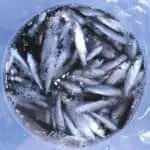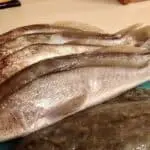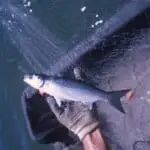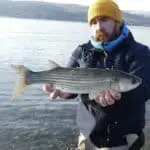Using a fly rod doesn’t have to always be about high mountain streams for trout, or crystal clear waters of the Bahamas for bonefish…
Enter: The humble mullet! Yes, you read that correctly. Fly fishing for mullet…
In this article, ill discuss why this growing trend may be the next big thing to hit saltwater fishing and go over a few tips to get you started.
Table of Contents
- Can You Catch Mullet On A Fly?
- Line, Tackle, And Gear Basics
- When To Go
- Where To Go
- Final Thoughts
- Related Posts
Can You Catch Mullet On A Fly?
Mullet are notorious for their difficulty to catch on hook and line, but targeting them with a fly may give you the edge you need to be successful.
In fact, anglers all over the world are using fly fishing equipment to catch mullet and having an absolute blast while doing it.
Part of the success can be attributed to the subtlety associated with fly fishing, and the skittish nature of a mullet.

They spook easily and eat small marine invertebrates and detritus, which makes them perfect targets to present small-sized flies.
They are often found in shallow water which can be salt, fresh or a mixture of both (brackish).
And lastly, mullets are found all over the world from the Carolinas to the Philippines.
Line, Tackle, And Gear Basics
If you have done any fly fishing you most likely have experienced a wide variety of fishing lines but when it comes to mullet there’s no doubt you are going to need some specific gear.
Fly Line
Sizes and styles will vary for each person but generally speaking a weight forward tapered line are what I recommend.
This will give you the weight needed to cast your line long distance, and allow it to sink to the bottom of the water column where mullet feed.
Fly-Rod Size
A standard 6 weight fly rod is the perfect all-around size to chase mullet and similar-sized inshore fish.
Remember, your just fighting the fish, your also fighting with waves, wind, and tidal action when fishing for mullet in saltwater locations.
Mullet Flies
When it comes to flies for mullet, think small…then think even smaller.
Here in Florida where I live, my favorite fly for mullet is the San Juan worm. If you have shrimp in your area, try a shrimp imitation fly on a #14 size hook.
Other popular mullet flies include flexi worm, rabbit ear nymph, and if your targeting them in freshwater try a black leech fly on a #16 hook!
Anything that mimics the small living creatures of your local inland waters should do, but keep the size and presentation between #18 and #12.
Also, you can utilize “chum” techniques just always check local laws and regulations regarding this.
When To Go
Depending on where you are in the world could greatly affect your chances to go after mullet with the fly gear.
There are numerous accounts of big fish being caught on beaches in several different states in November. Other times of the year you may catch them inshore in the spring.
Tide flows, bait presence, and time of day generally have an impact but practically speaking mullet can be caught most of the year if you know where to look.
As a very general rule, you should search the surf and offshore a bit during the winter and summer.
During the spring and fall, you can hit the inshore and waterways such as creek mouths, inlets, and backwater bays.
Where I live on the east coast of Florida, the mullet run takes place each fall and it is without a doubt the best time to fly fish for mullet (and tons of other fish too!).
Mullet will actually travel pretty far up the creeks and tributaries, but the biggest mullet usually won’t travel all the way back up the creeks as the small ones do.
Where To Go
The best and most versatile place to chase mullet with a fly-rod is Florida.
They are native to the region and could possibly be found in any body of fresh or saltwater throughout the sunshine state.
You will find the weather in Florida permits a longer fishery than most of the country. It is no strange sight to see a winter day well into the 60’s or even 70’s.
Florida also provides one of the most diverse fisheries you could possibly find. The tidal creeks are loaded with algae, plankton, and baitfish.
The coast is extremely diverse on both the Atlantic and the Gulf sides.
But Florida is certainly not the only place to chase these mullets with the fly…
The entire east coast of the United States is good fishing grounds for mullet. The Carolinas routinely tout some big mullet right off the beach during the colder months of the year.
Just three years ago the North Carolina mullet record was broken during the month of November.
The fish was over three pounds and caught while surf fishing in the outer banks of North Carolina.
And let’s not forget about fishing abroad!
Other destinations such as Scotland, Ireland, England, Spain, South Africa, and Australia all have mullet and offer great opportunities for fly fishing.
In fact, fly fishing for mullet may be more popular abroad than it is here in the United States…I wonder why that is?
Final Thoughts
The truth is that mullet get a bad rap.
They have this persona of weakness and boredom. There are some who even consider it a “trash fish” but, they are quite fun to catch, cook and eat.
Whether you find yourself on a boat in the Florida flats, on a loch in Scotland, or on a beach in the Carolinas, fly fishing for mullet is doable and can produce a day full of fun!
See Also: Is It Possible To Catch Mullet On Lures?

Growing up in Florida, I’ve been surrounded by saltwater my entire life…and I love sharing my passion with others.
To learn more about why I started Saltwater Mecca, visit the ABOUT page.
Thank you for reading this article. Browse around & have some fun!





